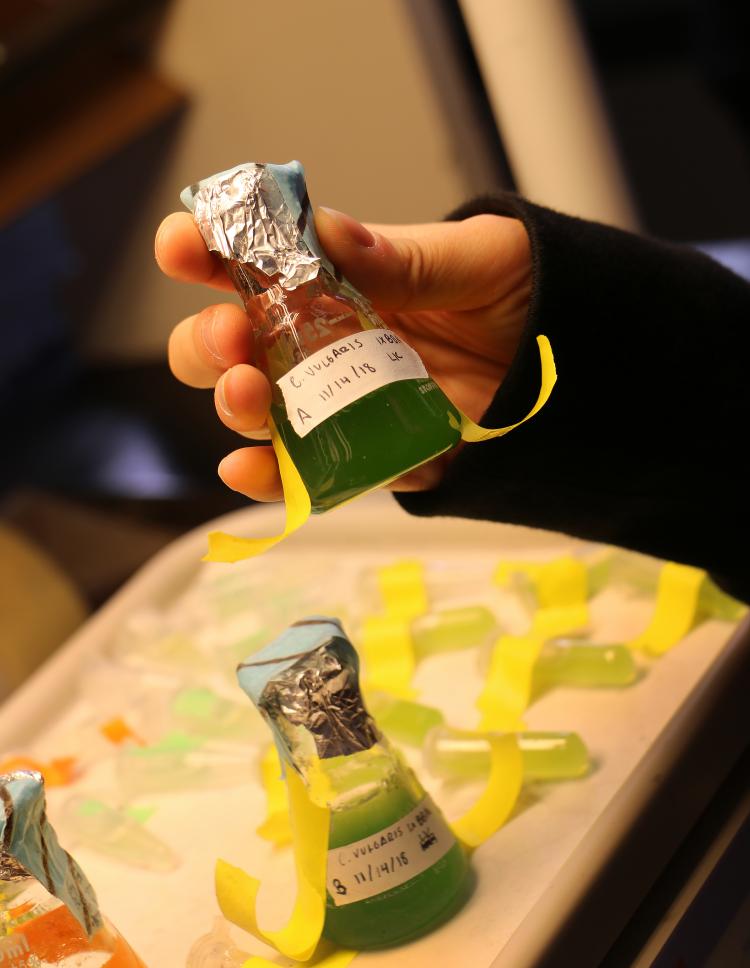A few years ago, the prospect of transforming algae into an alternative biofuel had numerous American companies seeing green – and not because of chlorophyll.
But while investors have spent hundreds of millions of dollars to alter our fuel consumption with algae, so far no one has found a way to mass produce algae fuel, says Dean Arakaki, associate professor of electrical engineering.
“If mass-produced algae biofuel is profitable, someone would have commercialized it,” said Arakaki, who has been working with students on algae for roughly eight years. “But it’s not.”

That hasn’t stopped efforts to explore algae as a potential fuel source.
“Considering the earth’s current ecological condition and the continuing footprint of the fuels we currently use, the need to find alternative fuels is definitely urgent,” said Juan David Gonzalez, one of two electrical engineering students currently working with Arakaki.
The concept has obvious appeal. Algae – or “pond scum,” as it’s sometimes called – exists as small aquatic organisms that convert sunlight into energy and store it in the form of oil. If that oil can be extracted from algae and refined into sustainable biofuels, it could represent a home-grown fuel source that would reduce greenhouse gas emissions.
“The reason why algae is so attractive is because you can raise it anywhere, and it doesn’t take up farmland,” Arakaki said.
The idea goes back to at least 1978, when the U.S. Department of Energy began funding a program to develop renewable transportation fuels from algae. In more recent years, companies like Exxon and Boeing have invested large amounts of money into researching the option. Universities have also joined the cause.
Arakaki responded to a Boeing call for help about eight years ago and received a one-time grant. His goal: Use pulsed electric fields to open algae cells to release lipids (fats) that can be refined into biofuel.
Gonzalez, who is constructing a homemade electroporator that creates the pulses, says the process is similar to muscles contracting when electrical impulses are applied. “Pulses should disrupt the membrane by exciting it.”
Boeing is primarily interested in creating alternative sources of jet fuel. But if algae fuel could be mass-produced, it would also be available for cars, Arakaki said.
His ongoing project has involved students in electrical engineering, biological sciences, food sciences and physics.

“The biology side raises the algae cultures,” Arakaki said. “They culture samples for our experiments.”
Oils can be extracted by breaking down the algae cells with solvents, sound waves or electricity. On the electrical side, pulses are applied at different intensity levels, Arakaki said. But there’s also great variety in algae species – over 100,000 different strains. So scientists test algae under many conditions to find the strains that grow quickly and are high in oil content.
And therein lies the challenge: To replace fossil fuels, there has to be a lot of algae, and the extraction and refinement process has to be cost-efficient. So far, the right formula remains elusive.
“Energy-dense fossil fuels are converted to gasoline using efficient, fine-tuned processes,” Arakaki said. “Hence, other methods have a long way to go to even compare to fossil fuel advantages.”
Some experts say we’re at least 20 years away from being able to use algae as a fuel source.

Arakaki’s project, however, introduces students to a multi-disciplined team environment.
“Opportunities like this allow one to work with people with different skills, personalities, backgrounds, and area of education,” Gonzalez said. “Such interactions teach a lot of interpersonal skills and long-lasting memories as one immerses in a diverse work and educational environment where team members learn from each other.”
And, he knows, some day – maybe even generations down the road – algae might just win the race to replace fossil fuels.
“It is an incredible experience that continues to push me and motivate me to always give 110 percent effort,” Gonzalez said, “as my contribution, whether big or small, could help in the overall impact that research like this could bring on the world.”


